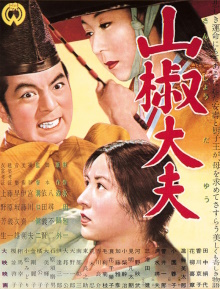I believe this is first film we’ve watched by Kenji Mizoguchi, one of the great directors of Golden Age Japanese cinema alongside the better known Akira Kurosawa and Yasujirō Ozu. This one is naturally one of his best works, apparently adapted from a folk tale. It’s a real tearjerker, piling tragedy after tragedy on top of its characters yet doesn’t feel over the top because of their folkloric origins. It’s absolutely brutal in portraying how pitiless the slave-owning society in medieval Japan was like. By the midpoint, I was ready to watch the protagonist lead a slave rebellion and burn it all down. This being not only a Japanese film but one that is all about imparting a Buddhist sense of mercy, this is very much not what happens.
For refusing to comply with orders to levy heavy taxes on peasants, the governor of a province is demoted and exiled. Before he parts with his wife and two children, the boy Zushio and the girl Anju, he advises them to always be merciful and gives them a statuette of Guanyin. Some years later while travelling overland, the three of them are tricked and captured by slavers. The mother is sold into prostitution far away and the two children become slave labor in a manor run by the rich Sanshō. The estate is backed by the powerful Minister of the Right and mercilessly exploits the slaves, branding those who try to escape and working them until the brink of death to be abandoned in the woods. Sanshō’s own son Tarō is disgusted by the system and does his best to help the two children until he leaves to become a monk. Eventually the two children grow up and become used to life on the estate. Anju remains kind but Zushio takes on a harder edge to survive and even helps oversee the other slaves. While teaching a new slave girl how to do the sewing work, Anju notices her singing to herself and realizes that the song is about Zushio and herself. The new girl tells her that it is a popular song where she is from, suggesting to Anju that her mother is still there.
I suppose the original folk tale must have been about the extreme cruelty of Sanshō because I don’t understand why else this film is named after him. The imagery here never gets graphic, but it leaves the viewer in no doubt as no how horrific the living conditions are. When the mother Tamaki repeatedly tries to run away, the owner of the brothel has her tendons severed. The slave overseers complain about the two children being too small and weak but put them to work anyway to make their money back. The worst part of it for me is that it’s systematic and goes all the way to the top. The three of them are first caught by a priestess who offered to shelter them only to betray them. Sanshō is praised by an official in Kyoto for paying his taxes on time and the productivity of his estate. It’s actually kind of shocking how so little heed is paid to religious values and it makes for one of the bleakest portrayals of medieval Japan I’ve ever seen. It’s a fine film in all respects, with great visuals, acting and a good sense of scale in transporting the viewer to the era.
Quite apart from the gut-wrenching spectacle of extreme suffering, it’s striking to me that at no point does the film turn into an incitement to armed rebellion or even self-defense against the oppressors. Though he grows up to become a sturdily built young man, Zushio never imagines that he can physically fight back. It’s mind-boggling to me that even after realizing that the slavery is condoned by the state itself, he still does his best to work within the system and appeals to the mercy and sense of justice of officials higher up in the hierarchy. This works to an extent or else this wouldn’t be much of a film but I can’t help but notice that it wouldn’t have worked at all if he wasn’t the son of an aristocrat in the first place. Indeed, that two aristocratic children are mistakenly sold into slavery is the point of the story in the first place. This is similar with many other folk tales and stories from all around the world so I wouldn’t blame this film specifically but it doesn’t endear me to it either. Likewise, its lessons on mercy and how it will eventually be repaid in turn as karma marks it out as being different from the Western conception of justice, but I wouldn’t agree with it either.
I’ve railed against films that amount to being nothing more than misery porn in the past. This gets more of a pass from me because it’s from an earlier filmmaking era and it’s set in a historical period when such suffering was commonplace. I consider this to be a very strong film and I can understand why it’s so highly regarded. Still, even if Kenji Mizoguchi deserves to be lauded as a peer of Kurosawa and Ozu, I’d say that he’s firmly in third place.
